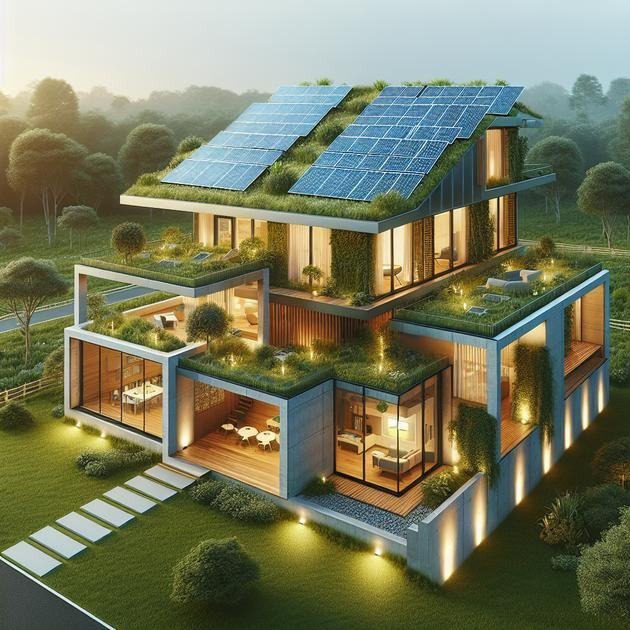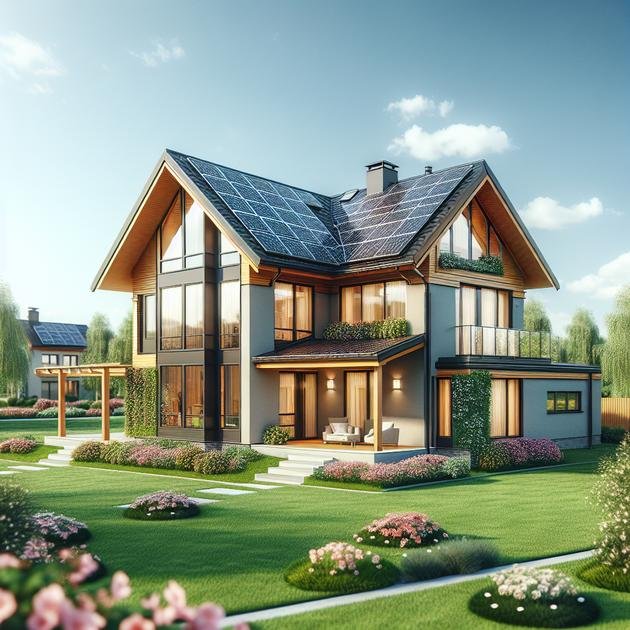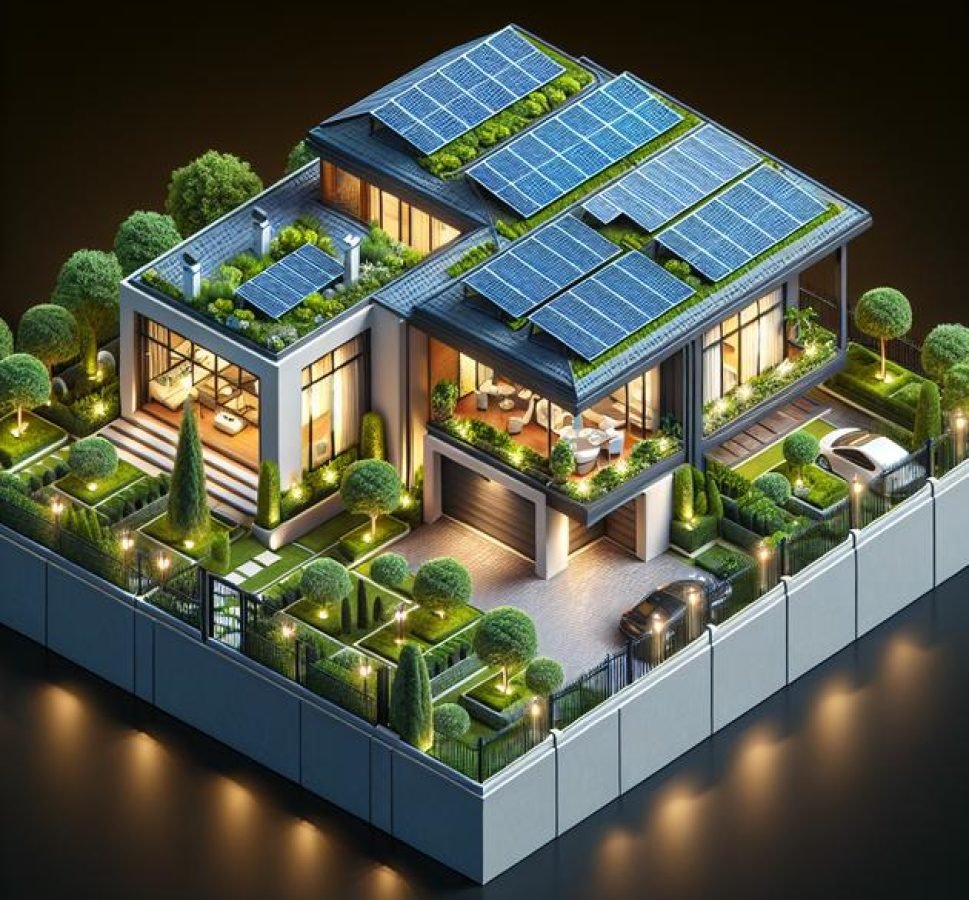Green energy home solutions involve using renewable sources like solar and wind power, combined with energy-efficient technologies and government incentives to reduce costs and environmental impact.
Green energy home solutions are more accessible than you might think. Ever wondered how small changes can create a big environmental impact? Let’s explore practical ways that can make your home eco-friendly without complicating your life.
understanding green energy basics
Green energy comes from natural sources that are constantly replenished, such as the sun, wind, and water. Unlike fossil fuels, these sources don’t run out and produce little to no pollution. Understanding green energy basics means knowing how these sources generate electricity and power homes sustainably.
Types of Green Energy
Solar power uses sunlight captured by panels to create electricity. Wind energy harnesses the power of wind with turbines. Hydropower generates energy from moving water. Biomass energy comes from organic materials, and geothermal taps heat from beneath the earth’s surface.
Why Choose Green Energy?
It reduces greenhouse gas emissions and dependence on finite resources. Green energy can save money in the long run, especially with lower utility bills and tax incentives. It also promotes a healthier environment for future generations.
How Green Energy Reaches Your Home
Electricity generated from renewable sources can be fed into the grid, making it available for residential use. Some homeowners install their own solar panels or small wind turbines to generate power directly, increasing energy independence.
By grasping these basics, you take the first step toward making eco-friendly choices that can positively impact both your wallet and the planet.
benefits of using green energy at home
Using green energy at home offers multiple benefits that go beyond just saving the environment. First, it can significantly lower your utility bills by reducing reliance on traditional electricity sources. Solar panels or wind turbines installed at home generate your own power, cutting costs over time.
Environmental Impact
Green energy reduces carbon footprint by lowering greenhouse gas emissions. This cleaner energy helps combat climate change and improves air quality around your neighborhood. By choosing renewable sources, you’re actively protecting the planet for future generations.
Energy Independence
Producing your own energy means less dependence on power companies and fossil fuels. This independence can protect homeowners from rising energy prices and power outages. Systems like solar with battery storage provide reliable energy during emergencies.
Increased Home Value
Homes equipped with green energy solutions often have higher market value. Buyers see solar panels and energy-efficient upgrades as attractive features that save money and support sustainability.
Government Incentives
Many regions offer tax credits, rebates, or financial incentives to encourage green energy adoption at home. These programs reduce the initial cost, making it easier for homeowners to switch to renewable energy.
By embracing green energy, you enjoy financial savings, environmental protection, and greater control over your energy use, all while supporting a cleaner future.
solar power options for homeowners

Solar power is one of the most popular green energy options for homeowners. It captures sunlight using solar panels, converting it into electricity to power your home. There are several solar power options to consider based on your needs and budget.
Grid-Tied Solar Systems
These systems connect to the local power grid. Any extra energy your panels produce can be sent back to the grid, often earning you credits or payments. It’s a cost-effective option since it doesn’t require batteries.
Off-Grid Solar Systems
Designed for homes not connected to the main power grid, these systems use solar panels combined with battery storage. They provide complete energy independence but usually come with higher upfront costs.
Hybrid Solar Systems
Hybrid systems work with both the grid and battery storage. They offer backup power during outages while still allowing surplus energy to be sent to the grid.
Solar Water Heaters
Besides electricity, solar energy can also heat water. Solar water heaters use sunlight to warm your water, reducing heating costs and energy consumption.
Choosing the right solar option depends on your location, energy needs, and long-term goals. Consulting with a professional can help maximize benefits and ensure proper installation.
wind energy for residential use
Wind energy for residential use involves harnessing wind power through small turbines installed at or near a home. These systems convert wind into electricity, providing a clean and renewable energy source for homeowners.
Types of Residential Wind Turbines
There are two main types: horizontal-axis and vertical-axis turbines. Horizontal-axis turbines are the most common and look like traditional windmills. Vertical-axis turbines are less common but can operate well in turbulent wind conditions.
Benefits of Wind Energy at Home
Using wind energy reduces dependence on fossil fuels and lowers utility bills. It offers energy independence and can be especially useful in windy areas where solar power might be less effective.
Installation and Maintenance
Proper site assessment is crucial to determine if your location has enough wind. Installation requires space and may need permits. Maintenance is generally low but includes regular checks for optimal performance.
Combining Wind with Other Green Energy
Many homeowners combine wind turbines with solar panels to create a hybrid system. This approach maximizes energy production by capturing both sunlight and wind, ensuring more consistent power generation.
Investing in wind energy at home is a step toward sustainability, reducing your carbon footprint while potentially saving on energy costs.
energy efficiency tips to reduce bills
Improving energy efficiency at home is one of the easiest ways to reduce your energy bills and environmental impact. Simple changes and smart habits can make a big difference in how much energy your household consumes.
Upgrade to LED Lighting
Switching from incandescent bulbs to LED lights saves energy and costs less over time. LEDs use up to 80% less energy and last much longer.
Use Energy-Efficient Appliances
Look for appliances with the ENERGY STAR label. These products meet strict energy-saving guidelines and help lower electricity consumption while maintaining performance.
Seal Leaks and Insulate
Proper insulation and sealing leaks around doors and windows keep your home temperature stable. This reduces the need for heating and cooling, which are major drivers of high energy bills.
Adjust Your Thermostat
Setting your thermostat just a few degrees lower in winter or higher in summer can lead to substantial savings. Consider programmable thermostats for automatic adjustments based on your schedule.
Unplug Devices When Not in Use
Many electronics use power even when turned off. Unplugging chargers and devices or using smart power strips can eliminate this “phantom” energy consumption.
Adopting these energy efficiency tips helps you save money and reduces your home’s carbon footprint, making it a win-win for your wallet and the planet.
smart home technology and green energy

Smart home technology plays a vital role in maximizing green energy use. By automating and controlling your home’s energy consumption, these technologies help increase efficiency and reduce waste.
Smart Thermostats
Smart thermostats learn your schedule and preferences to adjust heating and cooling automatically. This ensures comfort while saving energy and lowering utility bills.
Energy Monitoring Systems
These systems track your energy usage in real-time. They help identify high-consumption areas and allow you to make informed decisions to reduce waste.
Smart Lighting
Smart bulbs and lighting controls can turn lights on or off based on occupancy or time of day. Using LED bulbs with smart controls enhances energy savings.
Integration with Renewable Energy
Smart systems can prioritize using energy from solar panels or wind turbines installed at home. They can also manage battery storage, optimizing when to store or use energy.
Voice and Remote Controls
Controlling devices through voice assistants or smartphones makes it convenient to manage energy use from anywhere.
By combining smart home technology and green energy, homeowners can enjoy greater comfort, convenience, and savings while supporting a sustainable future.
government incentives and rebates
Government incentives and rebates make green energy solutions more affordable for homeowners. These programs are designed to encourage the adoption of renewable energy and energy-efficient technologies.
Types of Incentives
Incentives include tax credits, rebates, grants, and low-interest loans. Tax credits allow you to deduct a portion of your green energy system’s cost from your taxes. Rebates offer direct cash refunds after purchase or installation.
Federal Incentives
The federal government offers programs like the Investment Tax Credit (ITC) for solar panel installations. This credit covers a significant percentage of the system’s cost and can substantially reduce upfront expenses.
State and Local Programs
Many states and localities provide additional incentives, which vary widely depending on your location. These may include rebates for energy-efficient appliances, grants for home upgrades, or performance-based incentives.
How to Access Incentives
Start by researching programs available in your area through government websites or green energy organizations. Hiring a certified installer can help you navigate the application process and maximize your benefits.
Taking advantage of government incentives not only lowers costs but also accelerates your journey toward a greener home.
how to start your green energy journey
Starting your green energy journey can feel overwhelming, but breaking it down into simple steps can make the process manageable and rewarding. The first step is to evaluate your current energy use to understand where changes can have the biggest impact.
Conduct an Energy Audit
An energy audit helps identify inefficiencies in your home, such as drafts, poor insulation, or old appliances. Many energy companies offer free or low-cost audits.
Set Clear Goals
Decide what you want to achieve. Are you aiming to reduce your bills, lower your carbon footprint, or both? Clear goals will guide your choices.
Research Green Energy Options
Explore renewable options like solar panels, wind turbines, or geothermal systems. Consider energy efficiency improvements such as LED lighting and smart thermostats.
Start Small
You don’t have to change everything at once. Begin with simple upgrades like switching to LED bulbs or installing a programmable thermostat.
Seek Professional Advice
Consulting with green energy experts can help you choose the best solutions for your home and budget, ensuring safe and effective installations.
Explore Incentives
Check for government incentives, tax credits, and rebates that can reduce your initial costs.
By taking these steps, you can create a customized plan that fits your lifestyle, leading to long-term savings and a healthier planet.
Taking the Next Step Towards a Greener Home
Embracing green energy solutions for your home is a smart choice for both your wallet and the environment. By starting small and building on your efforts, you can create a more efficient and sustainable living space.
With the right knowledge, tools, and support, making the switch to green energy becomes easier and more rewarding. Every step you take helps reduce your carbon footprint and contributes to a cleaner planet.
Remember, the journey to green energy is personal and flexible. Choose the options that best fit your needs, and enjoy the benefits of a greener, healthier home.





